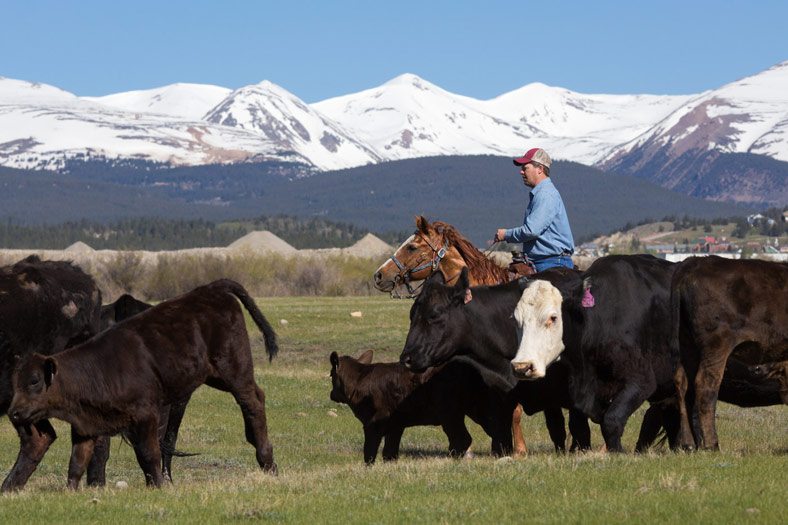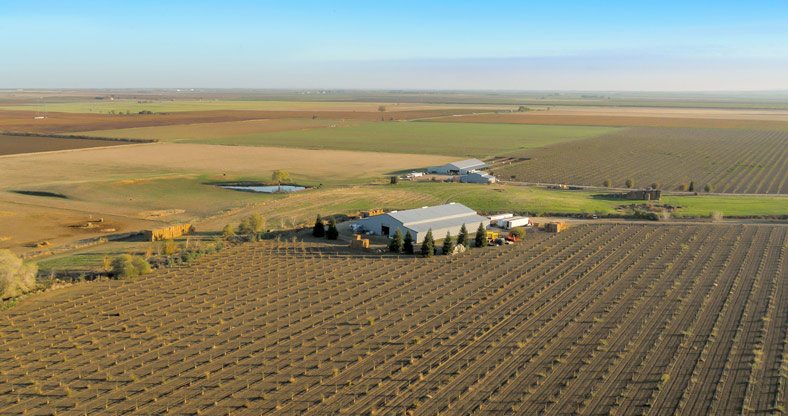From the time I was just a boy I have found myself surrounded by nature’s landscape, in all of its forms. From oak-filled hills to pasture bottoms, mountains dense with pines to coastal hills, Oakdale, California, offered a great place to grow up with a gun and fishing rod in hand. Hunting was instilled in me when I was young by my father, and finding ground to hunt on was an exciting challenge for my buddies and me.
Knocking on doors to gain access to pheasant hunting property came second nature back then, and Central Valley California yielded thousands of acres of private pasture ground that sustained excellent populations of healthy pheasants. We didn’t call them formal ranches, we just went down to the “Old Irishman’s” property and hunted pheasant after school, wading through the waist-high grass and busting pockets of birds with my trusty Lab. Yes they had cattle, but nothing like a major ranching operation. Just about a hundred acres, maybe 50 head of Angus and Charolais, coupled with the classic handful of hogs, chickens and a couple of border collies or heelers by their house and barn. There were hundreds of small farms along the valley floor from Bakersfield to Redding.
That has changed in the last two decades, and I will forever remember the fun we had as kids chasing the wily Ring-neck. Now, these properties are intensively managed almond and walnut orchards, dairies and vegetable farms. Gone are the pheasants, having been replaced by doves and various other species. Landowners were forced to grow more financially beneficial crops to meet the increasing demands from populations and taxes. Change is inevitable and growth is just going to happen. I now know that balance is the key. We are fortunate to work with some of the best stewards of this great land, farmers and ranchers who wake up every day to work with their hands on what they are passionate about . . . Land. Ever improving yields, habitat and the general landscape.
It’s 2017 and now I’m the marketing director for LandLeader. Three years into this and it’s now the largest land marketing company in America, reaching almost $3 billion in land sales throughout our national land marketing network made up of farm, ranch and rural and brokerages across the country. As I try to hold on to this ride working with the top land brokers in America, I’m exposed to stories just like this from coast to coast. With various market trends, cattle price fluctuation, grain markets and niche product demand, we continue to see landowners reinventing their properties to better serve their need for an increase in returns. Our brokers are there every step of the way pointing out market changes. Let’s take a look at some regional trends across the country.
Southeast
Contribution from Jon Kohler & Associates
Not every landowner has the convenience of keeping a property natural and in its perfect conservation and “habitat first” form. I’ve learned that “balance is the key.” Jon Kohler calls this the “conservation and land stewardship ethic,” which is a term of art meaning balancing nature with economic returns.
Recently I traveled to Thomasville, Georgia, to film a feature with Jon Kohler & Associates for our LandLeader Television show that airs on RFDTV. Our crew seeks out interesting and exciting stories about landowners and conservationists and their passion for the land. I had the true pleasure of visiting the Chemonie Plantation, a traditional quail plantation that harbors wild quail, and in recent years was partially converted to a cattle operation. Jon and Erica Kohler, C.J. Brown, Walter Hatchett and the crew followed championship Pointers as they bounded through the wiregrass following their keen nose in search of a wild bob.
Coveys rose that afternoon and the double guns cracked amid the yellowed grasses and longleaf pines. But just a hundred yards away and over a fence sprawled hundreds of acres of green pasture and a herd of Ultra Blacks, which is a type of Black Angus. Chemonie’s new owners created a higher yield of return so as to allow its plantation to be partially self-sustaining. In addition, the modern costs of managing lands are coming down, and the balance of recreational ground and income ground on the same property has evolved in the past decade.
Jon Kohler, the leading broker in the country for plantations and a LandLeader co-founder, supported this trend. “When talking about the balance of land stewardship and the conservation ethic, there’s a conflict. You have to balance peoples’ changing desires and economic needs, so for most people everything can’t be purely recreation. This property has been in flux since the 1830’s. At one time it was a cotton plantation, then in 1888 quail plantation asset class replaced that, and for the last 90 years Chemonie has been used to propagate wild quail populations. Now this owner has converted about 20 percent of the property to cattle operations, but not a traditional southeastern cattle ranch, more symbiotic to the land, planting legume and grasses that also benefit wildlife.”
One of our favorite things to do is to improve properties to the next higher asset class. Thankfully, in our market the best-managed natural properties are worth the most. – Jon Kohler
“One of our favorite things to do is to improve properties to the next higher asset class. Thankfully, in our market the best-managed natural properties are worth the most. Therefore, we can take a timber property and improve it for wildlife, aesthetics and timber and it will be worth more as a high quality recreational property than in the lower timber asset class. This adds value to the landowner and is the right thing to do with the land. It’s a win-win!” says Kohler.
We were joined by Tall Timbers President Dr. Bill Palmer, whose perspective on cattle conversions on southern plantations was based on understanding and deep knowledge. No doubt that habitat preservation and the conservation of quail ground and old-growth longleaf pine is pure in his passion. But he supports the practice of keeping properties from being overly commercialized.
“Some properties take segments of their land and maximize cattle production, some are planting agricultural crops. Having a balance between maintaining the biodiversity and natural resources—the core for quail land—and ensuring families can afford it and keep their property means developing other ways to increase economic potential.” Dr. Palmer went on to stress the importance and realization that costs to maintain these plantations is actually going down, with modernization of farming equipment and efficiencies in crops and cattle management.
Being based in Colorado and from the west coast, I never knew about the heritage of the Red Hills and the “plantation life” until working with the team at Jon Kohler & Associates. The landowners there take wildlife and land stewardship to a whole new level. The same goes for every other part of the country in which LandLeader has brokers, from Maine to California and throughout 35 states. Every area has its own critical areas and features. As a marketing enthusiast I have always tried to educate myself about the product I am promoting, and with a river of knowledge from our regional and local land specialists we have the tools, knowledge and passion for selling land in every cranny of this country.

Rocky Mountains & Great Plains
Contribution from Hayden Outdoors
Demand for agricultural ground is, of course, tied to rising and falling commodities prices. If beef prices are down, so is the demand for ranchland. If corn and wheat prices are in a slump, buyers are reluctant to invest in farm ground.
Generally, commodities cycles can play out independently of one another, with demand up in some sectors and down in others, and with corresponding effects on the land market. At present, agricultural commodities seem to be in a collective slump, with products from beef to small grains expected to experience declines in 2017. This has pushed land buyers to shift their focus away from agricultural ground and instead eye investments in recreational real estate, such as hunting and fishing properties.
“Today we are seeing many landowners mistakenly believe that the recreational markets are in the same place as the Agricultural markets in general,” says Dax Hayden, managing partner with Hayden Outdoors and the national director of LandLeader. “The recreational market is excellent and it is critical to find the highest and best use of any piece of land.”
The recreational market is excellent and it is critical to find the highest and best use of any piece of land. – Dax Hayden
Hayden, whose company markets working farms and ranches as well as hunting and fishing properties throughout the Rockies and Great Plains, points out that the boom in the recreational market need not leave sellers of agricultural operations in despair. In fact, the interest in sporting properties can create an effective marketing opportunity for agricultural landowners, tapping into what Hayden refers to as a “market within a market,” provided a farm or ranch has a bankable recreational element—be it a stretch of river frontage a great pheasant population or an environment that draws trophy deer and elk.
Farmers and ranchers with such properties, Hayden says, are capitalizing on the demand for recreational ground by marketing the hunting and fishing opportunities that exist within their agricultural operations. For example, cropland with river frontage or a section of a ranch known for great elk hunting might be leased or divided from the remainder of the property and sold at a premium price per acre, generating what likely would be a much-needed tool to keep a farmer or rancher in business.
Hayden cautions that such approaches require knowledge and a great amount of caution by the landowner and the broker. Plans like this need to be strategically executed with the long term future of the property in mind. Selling or leasing the wrong portion of the property or taxing the ability of the farm or ranch to generate future income must be avoided if possible. Doing this insures that the property will still be a viable agricultural operation. Landowners must think creatively and utilize all aspects of value. Recreational value is real and many times it can be a game changer.
Still, such market-within-a-market game plans can equip land brokers not only to help farmers and ranchers weather the ups and downs of the commodities markets, but also to create capital to strengthen the long-term viability of their businesses.
“As brokers,” Hayden says, “you might be able to help a family keep from losing their farm or ranch. My family has been through some hard times in agriculture and I know that saving a family operation can last for generations.”

West Coast
Contribution from California Outdoor Properties
In response to increased global demand for healthy, nutrient-rich nuts, much of California’s irrigated pastureland has been repurposed over the past two decades to create orchards growing almonds, walnuts and pistachios. Almond acreage alone has doubled over the last 20 years, according to the Almond Board of California, an industry advocacy group with more than a million acres currently devoted to the crop. In 2011, the value of the California almond harvest surpassed that of the state’s grape output, putting almonds second only to dairy products among California’s top commodities.
Land broker Todd Renfrew, owner of California Outdoor Properties, headquartered in Vacaville, California, says the trend has been a dominant theme in the state’s agricultural real estate market.
“A perfect example is a ranch with irrigated pasture on which you’re running cattle,” he says. “You have the grass, you have the water, you have the soil. Given the demand for orchard ground, though, those same resources can be put to use differently, and you have a much larger income stream.”
Renfrew specializes in selling farms and ranches throughout California. The pasture-to-orchards trend, he explains, has played out statewide, most visibly in the agriculture-oriented Central Valley. Long one of the world’s most productive farming regions, producing everything from tomatoes to cotton, the valley is now home to more than 6,000 almond growers who, according to the United Nations’ Food and Agriculture Organization, produce 60 percent of the world’s supply of the nut. In an effort to meet global demand, many growers have expanded their operations beyond the flat farm ground traditionally occupied by orchards, planting trees in surrounding lowland hills.
“Demand has driven the switchover from pasture to orchards,” Renfrew says. “There’s been a high demand for almonds, particularly in the Asian market—India and China. There aren’t that many areas in the world that can grow almonds. California’s one of them.”
Despite its recent dominance in the ag. market, though, the trend has shown signs of slowing. Prices for orchard ground have begun to come down, and urgency among buyers has calmed in comparison to the activity of recent years. “There’s still a big demand for almond and walnut trees,” Renfrew explains. “But buyers aren’t willing to pay as much as they have been paying.”
Still, California orchard properties continue to command serious money. A buyer selecting from currently available inventory might expect to pay between $16,000 and $60,000 per acre.
Renfrew identifies other trends impacting the California land market: an increased use of mechanical harvesters raising efficiencies, and thereby profits, in the grape and olive industries; and ongoing interest among landowners in pursuing conservation easements. It is the recent break in California’s five-year drought, though, that has landowners, investors and brokers feeling most enthusiastic.
“In the last few years, many properties still had the soil, but not the water,” Renfrew says. “Landowners drilled more wells, going deeper and deeper, which impacted the water table. In 2016, we had a tremendously wet year. The dams are full, so it’ll be interesting. There’s some question as to whether some of these orchards have been planted in areas where the water table might come up, and whether that will have an impact on the trees. Still, the rain we’ve had has people excited, and we’re optimistic about the market.”
Lands of yesterday may not, or will not, be the lands of tomorrow. It is important for all of us to work towards this balance of wildlife and production. Many times we see these two collide and not work together. This, however, does not have to be the case. I am lucky to work for companies who care about the land, the landscape and its people. It is important to always leave the land better than you found it. That is whether you own it or are just visiting. I have been reading the horror stories from the Midwest fires in Kansas, Nebraska and Oklahoma and I feel for those passionate farmers and ranchers dealing with death and devastation. I pray for those families who have lost loved ones and look towards the spring and greener grass.
The constant evolution of these properties and knowing the market trends and potential valuation is what our team of licensed land brokers and agents can offer our clients. When you look to buy real estate, keep in mind that what you purchase today could be modified and enhanced for tomorrow—and might just help you keep it for generations to come.
 DAN BRUNK is the Marketing Director for LandLeader and is based in Colorado. Dan brings over 20 years of marketing and advertising experience to the team from the real estate, television, publishing, retail marketing and communication industries. Brunk cut his teeth in the real estate industry as the Marketing Director for Hayden Outdoors, and still manages a marketing team that has helped Hayden Outdoors grow into an eight-state region and a leading brokerage in the West. Dan manages the marketing strategy for LandLeader globally and works closely with members to enable them with a strategic and efficient marketing campaign to work best for each brokerage member. Such tactics include a new national television show on RFDTV, integrated lead and syndication program leading online presence and yielding over 10 million brand impressions annually for LandLeader and its members. For interest in joining LandLeader, please contact (844) 281-4301.
DAN BRUNK is the Marketing Director for LandLeader and is based in Colorado. Dan brings over 20 years of marketing and advertising experience to the team from the real estate, television, publishing, retail marketing and communication industries. Brunk cut his teeth in the real estate industry as the Marketing Director for Hayden Outdoors, and still manages a marketing team that has helped Hayden Outdoors grow into an eight-state region and a leading brokerage in the West. Dan manages the marketing strategy for LandLeader globally and works closely with members to enable them with a strategic and efficient marketing campaign to work best for each brokerage member. Such tactics include a new national television show on RFDTV, integrated lead and syndication program leading online presence and yielding over 10 million brand impressions annually for LandLeader and its members. For interest in joining LandLeader, please contact (844) 281-4301.



